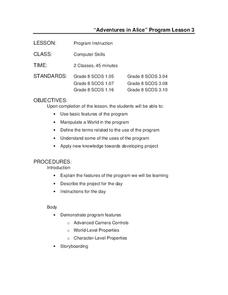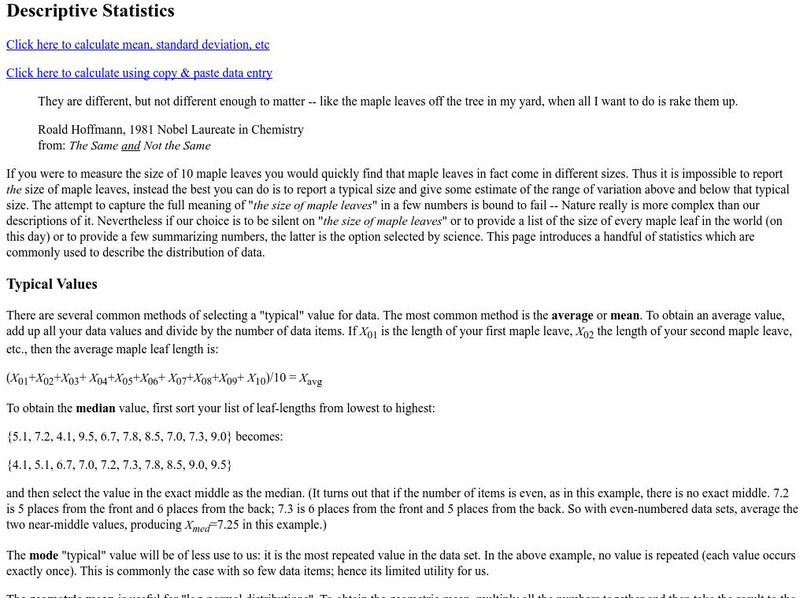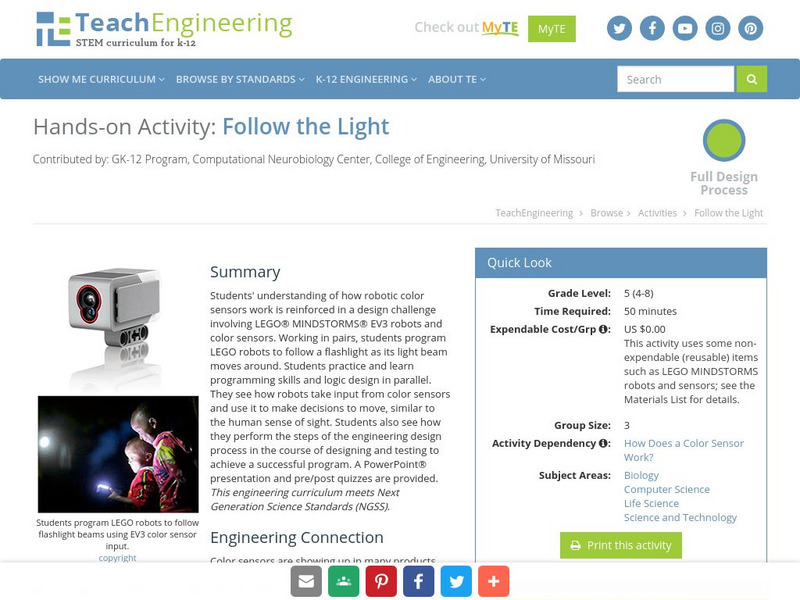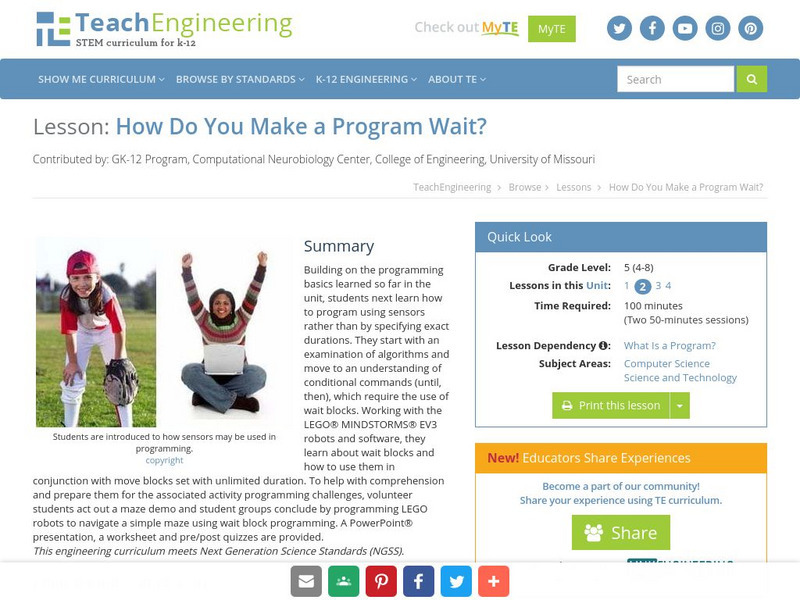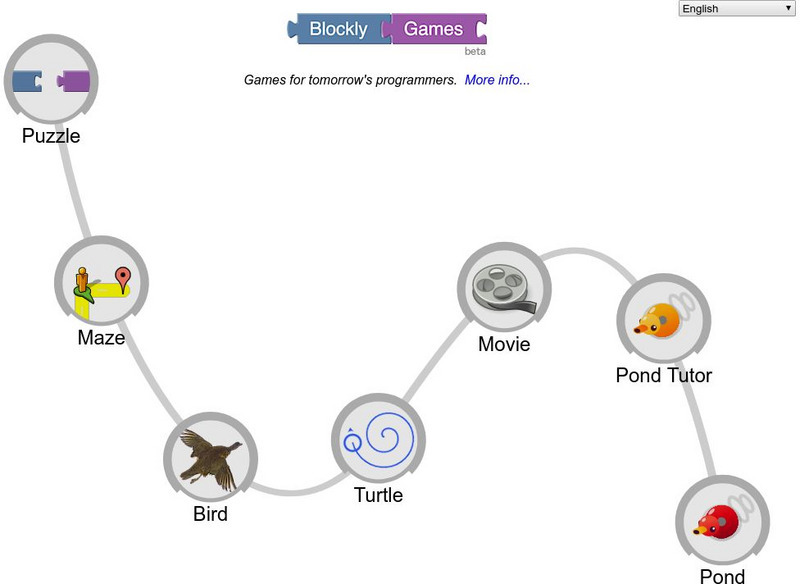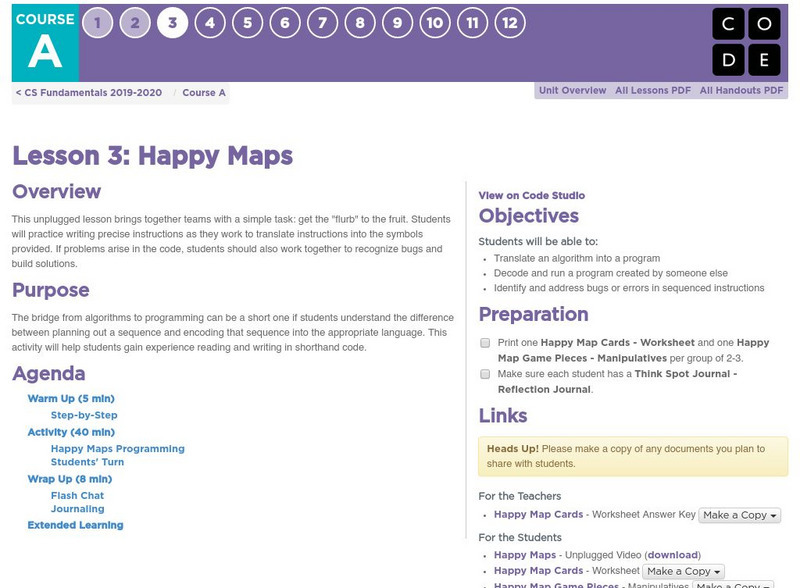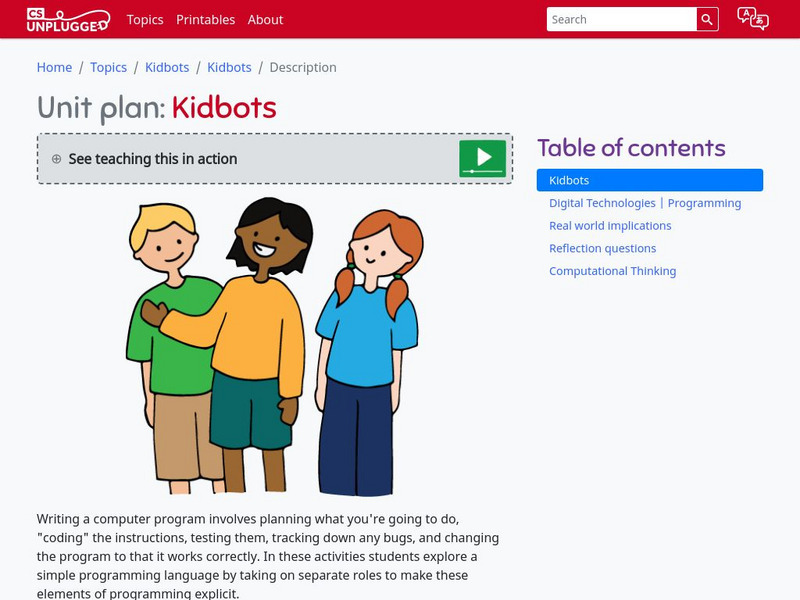Curated OER
Problem Solving in Computer Classrooms
Students discuss and implement basic problem solving techniques. They define program specifications and write programs. Students work cooperatively on programming problems and brainstorm solutions.
Curated OER
Adventures in Alice
Students complete a computer program in which they see how the programming language works for creating a virtual world. In this technology lesson students produce their own interactive video.
Curated OER
Adventures in Alice
Students use the Alice computer program and use the basic features to manipulate a world within it. In this programming lesson plan students use their computer skills to create a storyboard in the Alice program.
Curated OER
Computer Interfacing: Frequency Measurement - The Doppler Effect
Students explore the Dollper effect by finding the frequency and velocity of sound. In this velocity lesson, students determine the impulse during a collision by using their data and a software program.
Curated OER
Adventures in Alice
Students produce a development project with characters. In this investigative lesson students use a program to understand its basic features and how to create and insert characters.
Curated OER
Adventures in Alice
Eighth graders complete a computer program where they learn about different methods. In this computer lesson students see the differences between a world and character method and learn what they do.
Other
Descriptive Statistics
Very complete explanation of mean, standard deviation, etc. including an online calcluator for these statistics.
Rice University
Rice: Design Patterns for Parsing
A description of the design patterns that are common in software engineering.
TeachEngineering
Teach Engineering: Sumobot Challenge
Students apply their knowledge of constructing and programming LEGO MINDSTORMS NXT robots to create sumobots- strong robots capable of pushing other robots out of a ring.
TeachEngineering
Teach Engineering: Follow the Light
A lesson involving LEGO MINDSTORMS NXT robots and light sensors, student pairs program the robots to follow a flashlight as its light beam moves around.
TeachEngineering
Teach Engineering: How Do You Make a Program Wait?
Building on the programming basics learned so far in a corresponding Robotics unit, students learn how to program using sensors rather than by specifying exact durations. Working with the LEGO MINDSTORMS NXT robots and software, they...
TeachEngineering
Teach Engineering: Python Calculus
Students analyze a cartoon of a Rube Goldberg machine and a Python programming language script to practice engineering analysis. This exercise enables students to see the parallels between a more traditional mechanical engineering design...
Computer Hope
Computer Hope: Free Computer Help for Everyone
ComputerHope.com offers an archive of free computer-related information, including tutorials, troubleshooting tips, hints and more. Select "Hardware Listing" and "Software Listing" to choose from the extensive directory, or perform a...
Khan Academy
Khan Academy: Computer Programming: Advanced Js: Natural Simulations
Learn how to use JavaScript, ProcessingJS, and mathematical concepts to simulate nature in your programs.
Other
Google: Blockly Games
A series of educational games that teach programming to students. It is designed for children who have not had prior experience with computer programming. By the end of these games, players are ready to use conventional text-based...
University of St. Andrews (UK)
University of St. Andrews: Alan Turing
This site from the University of St. Andrews provides an extensive biography on Alan Turing details his childhood, education, accomplishments, invention of the Turing machine, and more.
Code.org
Code.org: Cs Fundamentals: Happy Maps
The bridge from algorithms to programming can be a short one if students understand the difference between planning out a sequence and encoding that sequence into the appropriate language. This activity will help students gain experience...
Code.org
Code.org: Cs Fundamentals: The Big Event
Students will soon learn that events are a great way to add flexibility to a pre-written algorithm. Sometimes you want your program to be able to respond to the user exactly when the user wants it to. Events can make your program more...
Code.org
Code.org: Cs Fundamentals: Lesson 10: Loops With Rey and Bb 8
Building on the concept of repeating instructions from "Getting Loopy," this stage will have learners using loops to help BB-8 traverse a maze more efficiently than before.
Code.org
Code.org: Cs Fundamentals: My Loopy Robotic Friends
A reintroduction to loops, using the set of "robot" programming instructions. Learners will develop critical thinking skills by looking for patterns of repetition in the movements of classmates and determining how to simplify those...
University of Canterbury
Cs Unplugged: Unit Plan: Kidbots
Writing a computer program involves planning what you're going to do, "coding" the instructions, testing them, tracking down any bugs, and changing the program to that it works correctly. In these activities students explore a simple...
Code.org
Code.org: Cs Fundamentals: Course C
Create programs with sequencing, loops, and events. Translate your initials into binary, investigate different problem-solving techniques, and learn how to respond to cyberbullying. At the end of the course, create your very own game or...
Other
Digital Promise: Video Game Remix
Learn about the basics of programming with Scratch, a visual programming language, and remix an online game.




